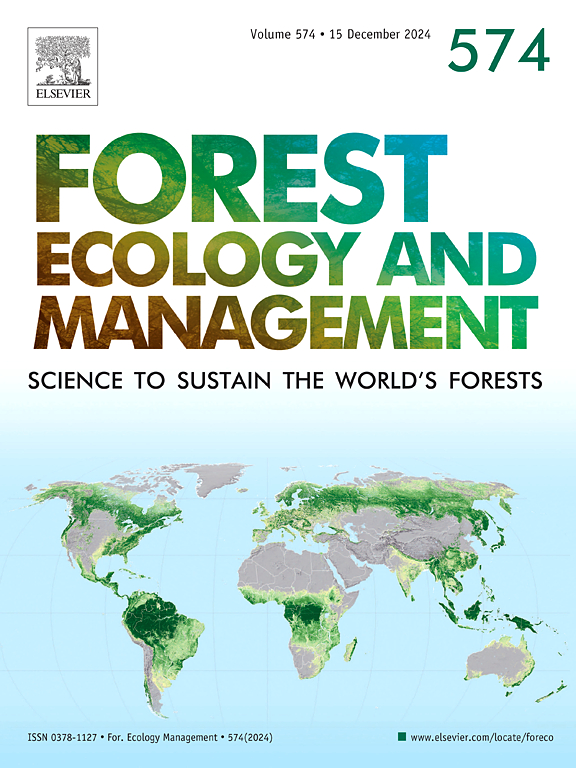Beetles, wind, and fire: Effects of climate change and close-to-nature forestry on disturbance predisposition and ecosystem service trade-offs
IF 3.7
2区 农林科学
Q1 FORESTRY
引用次数: 0
Abstract
Close-to-nature forestry (CNF) is considered an effective strategy to adapt forests to climate change while sustaining ecosystem services and biodiversity (BES). However, for forest management it remains unclear whether current CNF strategies sufficiently reduce forests’ predisposition to climate-change-induced shifts in disturbance regimes. To address this increasing complexity, we introduce the integration of a climate-sensitive forest gap model with assessments of predisposition to fire, bark beetle, and windthrow disturbances, as well as BES provision. We conducted simulations for a forest enterprise in the Central Swiss Alps, covering a large elevation gradient, under three climate scenarios (historical, SSP2–4.5, and SSP5–8.5). The simulations additionally considered six management strategies, including CNF variants with different management intensities and climate-adapted approaches. Our results indicate that climate change will dynamically alter disturbance predisposition across elevation gradients. Site-related predisposition to fire and bark beetle infestation generally increased under climate change, while stand-related predisposition to all disturbances varied with climate scenario and elevation. Under moderate warming (SSP2–4.5), stand-related predisposition to fire and windthrow increased across all elevations. In contrast, under severe warming (SSP5–8.5), long-term reductions in stand-related predisposition to fire, bark beetle infestation, and windthrow occurred at lower elevations due to climate-change-induced shifts in forest dynamics, while predisposition increased at higher elevations with improved growing conditions. Our results further show that increasing management intensity generally reduces stand-related disturbance predisposition but focusing purely on disturbance mitigation can also lead to trade-offs, such as reduced BES provision. We conclude that climate-adapted forest management must account for both stand-related and site-related predisposition to prioritize disturbance-prone ‘hotspots’, especially in areas of high BES value. Proactively reducing disturbance predisposition may involve trade-offs regarding BES provision but may be crucial to avoid potential BES losses from severe disturbances. As climate change may alter trade-offs between BES and disturbance mitigation, we underscore the need for decision support systems in long-term forest planning to account for conflicting management objectives.
求助全文
约1分钟内获得全文
求助全文
来源期刊

Forest Ecology and Management
农林科学-林学
CiteScore
7.50
自引率
10.80%
发文量
665
审稿时长
39 days
期刊介绍:
Forest Ecology and Management publishes scientific articles linking forest ecology with forest management, focusing on the application of biological, ecological and social knowledge to the management and conservation of plantations and natural forests. The scope of the journal includes all forest ecosystems of the world.
A peer-review process ensures the quality and international interest of the manuscripts accepted for publication. The journal encourages communication between scientists in disparate fields who share a common interest in ecology and forest management, bridging the gap between research workers and forest managers.
We encourage submission of papers that will have the strongest interest and value to the Journal''s international readership. Some key features of papers with strong interest include:
1. Clear connections between the ecology and management of forests;
2. Novel ideas or approaches to important challenges in forest ecology and management;
3. Studies that address a population of interest beyond the scale of single research sites, Three key points in the design of forest experiments, Forest Ecology and Management 255 (2008) 2022-2023);
4. Review Articles on timely, important topics. Authors are welcome to contact one of the editors to discuss the suitability of a potential review manuscript.
The Journal encourages proposals for special issues examining important areas of forest ecology and management. Potential guest editors should contact any of the Editors to begin discussions about topics, potential papers, and other details.
 求助内容:
求助内容: 应助结果提醒方式:
应助结果提醒方式:


